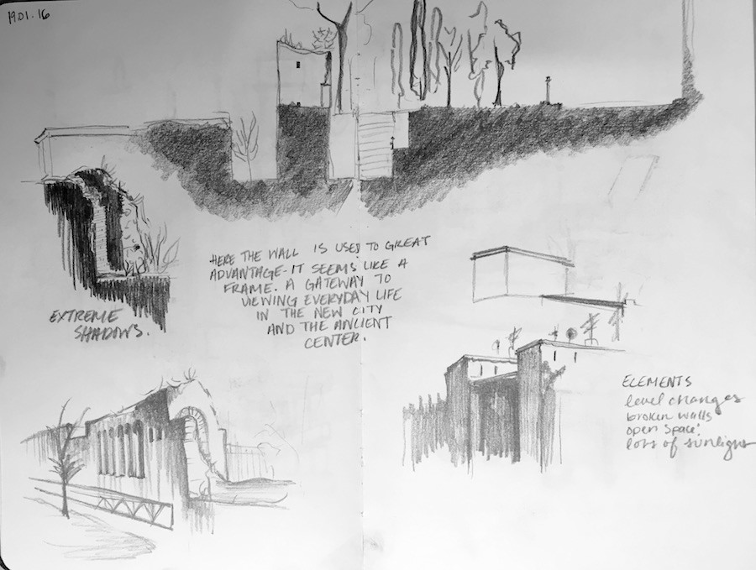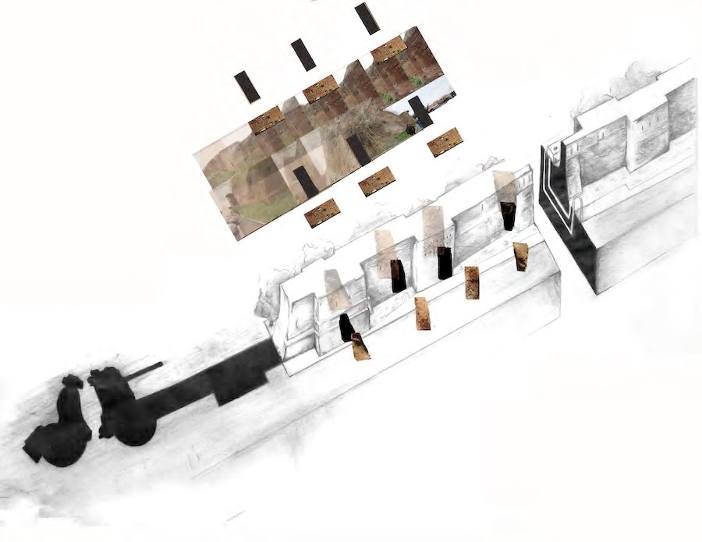Mikesch Muecke
Iowa State University, Ames, IA
mikesch@iastate.edu
Summary statement
An in-depth analysis of the Aurelian Wall in many of its intended and corollary uses, materially, phenomenologically, and symbolically, over its 1700 years of existence as a formidable Roman structure, as read through the design work of fourth-year American architecture and landscape architecture students in Rome during the Spring semester 2016.
Topic
The Aurelian Wall as an existential place and and as a utopian projection of ideas about phenomenology, context, and pre-existing conditions. The focus of the work is on qualitative rather than quantitative experience.
Scope
The Aurelian Wall in Rome, built as a twelve-mile long defensive structure between 271 CE and 275 CE, exists for the most part still in the contemporary city as both a connector and divider between neighborhoods, a monument to the subtle fear of an imperial power losing its influence. But it is also a built environment whose initial defensive task has shifted over the last 1700+ years so that now it is part of the continuous city fabric that includes cemeteries, a pyramid, residences, places for birds to nest, an amphitheater, and numerous other uses. In other words, the Wall’s meaning has shifted from a projected object of defense to a long necklace of existential spaces for contemporary inhabitants of the city.
During the mid-to-late 1950s, at a time of high-modernist object buildings in Italy and elsewhere, Ernesto Rogers (1909-1969)—then editor for Casabella—dared to define architecture as a “dialogue with its surroundings.” A key idea in this definition is what Italians call the preesistenze ambientali or pre-existing environmental conditions, or context. The last term—context—is what the translators of Aldo Rossi’s 1966 The Architecture of the City, Diane Ghirardo and Joan Ockman, used instead of the more cumbersome term ‘pre-existing environmental conditions’. What mattered perhaps more than this divergence in meaning of the original Italian from the translated English is the idea of continuity that is implied in the original, and which is missing in the English version. The ambientali part of the term comes from the French ambiant, Latin ambient ‘going around’, a kind of walking (ambulare). In other words, preesistenze ambientali implies a continuous movement through space and time,[1] suggesting the absence of a clear distinction between architecture and landscape.[2]
This continuity-based approach to designing our built environment foregrounds language as a method of knowing, the way both Martin Heidegger for philosophy and later Christian NorbergSchulz for architecture define fundamental relations of humans with the world. In the late 1970s Norberg-Schulz starts with language—borrowing from philosophy—of how we describe our world through words. Memorable spaces make places. And a place combines enclosure—a wall—and gathering of people, animals, of something separating itself on the inside from what is on the outside of the wall. The ‘going around” of the preesistenze ambientali has a temporal connotation as well: we depart and we return, we leave and we come back.
If we follow Heidegger and Norberg-Schulz, the Aurelian Wall as a concrete, qualitative entity exists with us as an existential place between the sky and the earth. How it exists, how its places are structured as a combination of landscape and settlement, I will analyze through its space (its three-dimensional organization) and character (atmosphere). The Aurelian Wall as a gathering place creates an inside and an outside, an enclosure and an extension. Through it Rome became a settlement in the landscape.[3] Its boundary, to use Heidegger’s term is “something that begins its presencing.”
Initially I will study the idea of the wall in architecture at its most fundamental level, as a mark in the landscape, using Norberg-Schulz’ approach to understand the Wall as a gathering and enclosing force. Then I continue through the analysis of such phenomenological spaces as Peter Zumthor’s Therme in Vals where architecture embraces the passing of time—and humans realize that they are in the presence of something that will surpass their own time on earth—and Steven Holl’s St. Ignatius Chapel in Seattle, where the wall becomes a generator of ethereal light during the daytime, and a projector at night.
Finally I will focus on the Aurelian Wall as a projection of Utopian ideas. In the Spring of 2016 the author was part of an architecture studio and drawing course that took as its task to rethink how American students are taught in Rome. Both the studio and drawing course had the Aurelian Wall as its focus, based on the international and interdisciplinary WallWalk that took place in 2014/2015.[4] Out of this history we decided to teach the course as a series of iterative sensorybased exercises where students used drawing, collage, montage, soundscape recordings, and other tools to rethink the roles the Aurelian Wall plays in contemporary Rome, based on their understanding of its meaning in the city, a meaning, moreover, that is tied to each students’ specific background, town of origin; that is to say their sense of identity as an (initial) stranger in the city. In this analysis the Wall fundamentally resists being understood as an architectural object and becomes more and more the utopian representation of a shifted idea about inhabitation, presencing, and place-making.
Throughout the presentation I ask qualitative rather than quantitative questions: how is the ground on which we walk? How is the sky above our heads? How are the boundaries that define the place? Using Norberg-Schulz’ Structure of Place as an equivalent to the Structure of Language we asked students to describe their understanding of the wall through nouns (places), prepositions (spaces), and adjectives (characters). And we borrowed Norberg-Schulz’ (via Heidegger) idea of dwelling as the realization of orientation/location in a specific space, and understanding the character of that space. In other words: how do I dwell in this space?
The intensity of the urban experience of the Aurelian Wall and its continuity with the landscape parallels the presentation: the combination of images and words create an intensity of reception, not unlike the effect the Wall has on the urban inhabitant within the preesistenze ambientali of Rome.
Case Study
As a case study I reference some of the work of my students in Rome, as well as the work of two established architects and one artist: Peter Zumthor’s Therme in Vals, Steven Holl’s St. Ignatius Chapel in Seattle, and James Turrell’s Sky Catchers.

Figure 1: Plan of Rome, Pietro del Massaio, 1469.

Figure 2: Project 1, Walking, Talking, Drawing the Aurelian Wall. By permission of Elizabeth Walling.

Figure 3: Project 3, Along/Across/Between the Aurelian Wall. By permission of Michael Havel, Ashton Knepper, Kerrick McCann.

Figure 4: Project 3, Along/Across/Between the Aurelian Wall. By permission of Tripti Upreti, Monica Rodriguez, and Mikaela Meierhofer.

Figure 5: Project 4, Continuity or Not along the Aurelian Wall. By permission of Alicia Pierce and Austin Smock.
Intended Conclusions
Living in a foreign city for four months creates in students a conflict between their memory of the known (their home back in the US) and, in this case, the new environment of the city of Rome. Rather than try to colonize the new with what students know already, i.e. transferring one’s home more or less unconsciously into the known, our goal was to accept our role as strangers and focus on the process of becoming familiar with an initially foreign place through the framing of small, lightweight, and mobile projects that addressed the Aurelian Wall as a physical and theoretical construct within the fabric of the city.
What is discernible in the presented student work is both an appreciation for the physicality of dwelling across/along/between the Wall as well as a historical understanding of dwelling as collage (the juxtaposition of fragments) between the known and the unknown, between the here/now and utopia.
References
Heidegger, Martin. “Bauen, Wohnen, Denken.” In Gesamtausgabe: Vorträge Und Aufsätze, 147-64. Frankfurt am Main: Vittorio Klostermann, 2000 [1951].
Holl, Steven. Anchoring : Selected Projects, 1975-1991. 3rd ed. (New York, NY: Princeton Architectural Press, 1991).
Holl, Steven. The Chapel of St. Ignatius. 1st ed. (New York: Princeton Architectural Press, 1999).
Holl, Steven. Parallax. (Basel ; Boston, New York: Birkhäuser-Publishers for Architecture; Princeton Architectural Press, 2000).
Norberg-Schulz, Christian. Genius Loci: Towards a Phenomenology of Architecture. (New York: Rizzoli, 1980).
Pallasmaa, Juhani. The Eyes of the Skin : Architecture and the Senses. (Chichester, Hoboken, NJ: WileyAcademy; John Wiley & Sons, 2005).
Zumthor, Peter. Atmospheres : Architectural Environments, Surrounding Objects. (Basel; Boston: Birkhäuser, 2006).
Zumthor, Peter, Maureen Oberli-Turner, and Catherine Schelbert. Thinking Architecture. 2nd, expanded ed. (Basel; Boston: Birkhäuser, 2006).
Zumthor, Peter, and Architekturgalerie (Lucerne Switzerland). Three Concepts : Thermal Bath Vals, Art Museum Bregenz, “Topography of Terror” Berlin. (Basel ; Boston: Birkhauser Verlag, 1997).
[1] Aldo Rossi’s Teatro del Mondo from 1979 comes to mind as a poetic construction of something that appears and then disappears.
[2] In fact, this continuity implied in the term preesistenze ambientali represents still today one of the main differences between European and North American architects’ approach to their profession. For Europeans, in general, there is no distinction between architecture and landscape while in US schools we have separate departments for each discipline.
[3] The Aurelian Wall was, of course, preceded by the Servian Wall, but Aurelian’s construction is the first to encompass the whole of what was Rome at that time, including its seven hills and Trastevere.
[4] http://www.inaquicarnicero.com/2014-Wallwalk-Project-Roma-Tre



